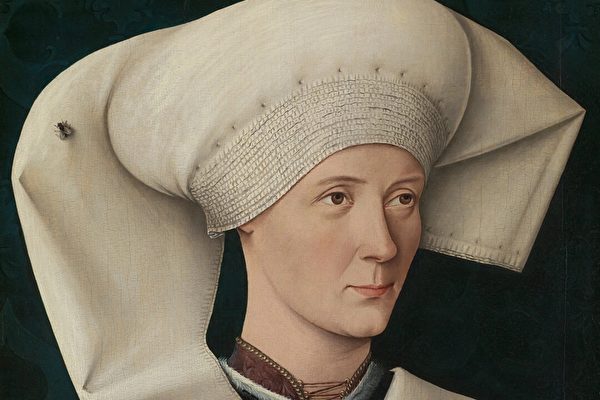When observing the 15th-century painting “Portrait of a Woman From the Hofer Family,” one immediately notices something peculiar. Painted by a German artist, the portrait features a curious detail – a lifelike white headscarf worn by the subject, with a fly painted on it. “Why does this lady have a fly on her head?” posed Francesca Whitlum-Cooper, the Associate Curator at the National Gallery in London, in a video. “What kind of trick is the artist playing?”
Whitlum-Cooper introduced the background of the artwork, highlighting the exorbitant prices of portrait paintings during that era, a luxury even for the wealthy. Commissioning a portrait was a rare occasion in one’s lifetime, requiring the sitter to wear their finest clothes and present their most dignified self.
The process of sitting for a portrait could take hours, and completing the artwork would require a significant amount of time. Imagine the artist intentionally adding a fly to your precious portrait – what a sensation it must be.
Created around 1470 by a painter from southwestern Germany, this painting represents the centuries-long pursuit of artists to freeze time, capturing a moment of truth.
Whitlum-Cooper believes that every detail in this portrait design is aimed at showcasing affluence: the lady’s attire crafted from intricate brocade fabric adorned with elaborate metal clasps. The portrait is meticulously executed, portraying a young woman with smooth unwrinkled features, wearing expensive gold rings. The white headscarf is immaculate, likely laundered and pressed repeatedly, another sign of a lavish lifestyle.
“Looking at the headscarf brings us back… to this annoying fly, with its bulbous eyes, transparent wings, depicted in such detail that you can not only see the slender legs of the fly but also their shadow on the headscarf,” Whitlum-Cooper remarked. “Why would the artist place a fly on the head of this lovely lady?”
She suggests it was a playful gesture. According to Whitlum-Cooper, this playfulness was cleverly executed: on one hand, the fly is fooled into thinking the headscarf is real, while the initial reaction of viewers believing there is a fly leads them to want to shoo it away.
“We’ve been tricked,” Whitlum-Cooper said. “Everything in the oil painting is two-dimensional. The artist employs techniques to turn a mixture of pigments, brushstrokes, and a bit of wood into something so lifelike. We can briefly believe, even if just for a second, that there’s a fly resting on the painting.”
She points out that the lady lived in a vastly different environment centuries ago, unlike today, where images are everywhere, and everyone carries a camera in their pocket.
“The artist is saying, ‘Look, this is how I capture moments from my surroundings.'”
The manipulation of viewers, making the imaginary appear real, can be traced back to the origins of painting.
Whitlum-Cooper mentioned, “In Western tradition, painting is thought to have begun in ancient Greece in the 5th century BC,” before discussing the concept of “radical illusionism,” where artists render portraits so realistic that even nature may mistake them for real.
She believes the lady depicted in the portrait was surely in on the joke: “The artist couldn’t have put the fly in the painting without her knowledge. I see her slight smirk, and then I look at that fly, and I think she knew what was happening at that moment, wanting to play a joke on people, to prank her friends and family when they saw the painting.”
The identity of the lady in the portrait remains a mystery, but she holds an intricately crafted forget-me-not flower. Whitlum-Cooper suggests that this flower symbolizes love, possibly commemorating an engagement or marriage. The type of flower may offer further clues.
She said, “The name of this flower, forget-me-not, is about memory or not forgetting people. Is this painting meant to make us remember this woman? It’s unclear.”
This portrait is thought-provoking, with a backstory. Whitlum-Cooper shared that this painting was once owned by Prince Albert, the husband of Queen Victoria, who gifted it to her as a present, and later, upon his encouragement, she donated it to the nation.
“Whatever the story of this lady is, it has a love story that made its way to us,” she said. “This painting may not be the largest or most important in our art collection, but it is a piece worth admiring closely.”
Whitlum-Cooper expressed that “Portrait of a Woman From the Hofer Family” not only makes her smile each time she views it but also serves as a reminder that “great artists always keep us on our toes.”

